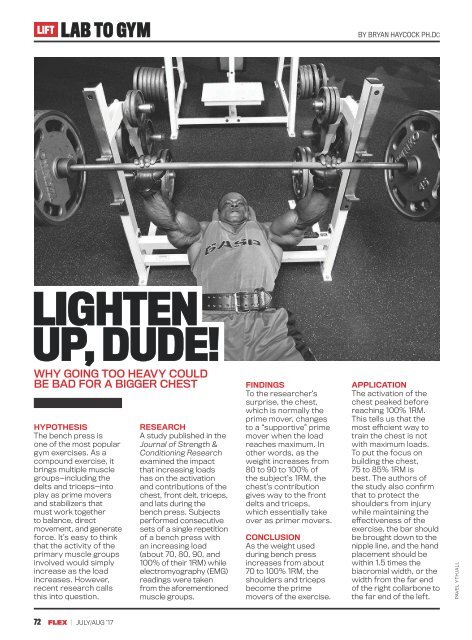Flex_USA_JulyAugust_2017_2
Create successful ePaper yourself
Turn your PDF publications into a flip-book with our unique Google optimized e-Paper software.
LIFT<br />
LAB TO GYM<br />
BY BRYAN HAYCOCK PH.DC<br />
LIGHTEN<br />
UP, DUDE!<br />
WHY GOING TOO HEAVY COULD<br />
BE BAD FOR A BIGGER CHEST<br />
HYPOTHESIS<br />
The bench press is<br />
one of the most popular<br />
gym exercises. As a<br />
compound exercise, it<br />
brings multiple muscle<br />
groups—including the<br />
delts and triceps—into<br />
play as prime movers<br />
and stabilizers that<br />
must work together<br />
to balance, direct<br />
movement, and generate<br />
force. It’s easy to think<br />
that the activity of the<br />
primary muscle groups<br />
involved would simply<br />
increase as the load<br />
increases. However,<br />
recent research calls<br />
this into question.<br />
RESEARCH<br />
A study published in the<br />
Journal of Strength &<br />
Conditioning Research<br />
examined the impact<br />
that increasing loads<br />
has on the activation<br />
and contributions of the<br />
chest, front delt, triceps,<br />
and lats during the<br />
bench press. Subjects<br />
performed consecutive<br />
sets of a single repetition<br />
of a bench press with<br />
an increasing load<br />
(about 70, 80, 90, and<br />
100% of their 1RM) while<br />
electromyography (EMG)<br />
readings were taken<br />
from the aforementioned<br />
muscle groups.<br />
FINDINGS<br />
To the researcher’s<br />
surprise, the chest,<br />
which is normally the<br />
prime mover, changes<br />
to a “supportive” prime<br />
mover when the load<br />
reaches maximum. In<br />
other words, as the<br />
weight increases from<br />
80 to 90 to 100% of<br />
the subject’s 1RM, the<br />
chest’s contribution<br />
gives way to the front<br />
delts and triceps,<br />
which essentially take<br />
over as primer movers.<br />
CONCLUSION<br />
As the weight used<br />
during bench press<br />
increases from about<br />
70 to 100% 1RM, the<br />
shoulders and triceps<br />
become the prime<br />
movers of the exercise.<br />
APPLICATION<br />
The activation of the<br />
chest peaked before<br />
reaching 100% 1RM.<br />
This tells us that the<br />
most efficient way to<br />
train the chest is not<br />
with maximum loads.<br />
To put the focus on<br />
building the chest,<br />
75 to 85% 1RM is<br />
best. The authors of<br />
the study also confirm<br />
that to protect the<br />
shoulders from injury<br />
while maintaining the<br />
effectiveness of the<br />
exercise, the bar should<br />
be brought down to the<br />
nipple line, and the hand<br />
placement should be<br />
within 1.5 times the<br />
biacromial width, or the<br />
width from the far end<br />
of the right collarbone to<br />
the far end of the left.<br />
PAVEL YTHJALL<br />
72 FLEX | JULY/AUG ’17

















